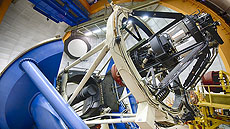DECam's far-out forays
 |
| The Dark Energy Camera does even more than its name would lead you to believe. Photo: Reidar Hahn
|
The Dark Energy Survey, which studies the accelerating expansion of our universe, uses one of the most sensitive observing tools that astronomers have: the Dark Energy Camera.
Built at Fermi National Accelerator Laboratory and situated on the Victor Blanco 4-meter telescope in Chile, the camera spends 30 percent of each year collecting light from clusters of galaxies for DES.
Another chunk of time goes to engineering and upgrades. The remaining one-third is split up among dozens of other observing projects.
A recent symmetry article looked at some of those projects — the ones that are studying objects within our solar system. In this follow-up, we give a sampling of how DECam has been used to reach even farther into the universe.
Studying stellar oddballs
The sun is a "normal" star, humming along, fusing hydrogen to helium in its core. Most of the stars in the universe produce energy this way. But the cosmos contains a whole collection of stranger stellar objects, such as white dwarfs, brown dwarfs and neutron stars. They also include exploding stars called supernovae. Ten projects use the DECam to study these stellar varieties.
Armin Rest, an astronomer at the Space Telescope Science Institute in Baltimore, Maryland, leads two of those projects. In the past two years, he has spent 28 nights at the Blanco Telescope looking for supernovae.
In both projects, Rest looks for light released during stellar explosions that has bounced off dust clouds on its way to our night sky. These "light echoes" preserve information about the blasts that caused them — for example, what type of star exploded and how it exploded.
"It is as if we have a time machine with which we can travel back in time and take a spectrum with modern instrumentation of an event that was seen on Earth hundreds of years ago," Rest says.
DECam's expertise in taking fast pictures of big areas makes this search much more efficient than it would be with other instruments, Rest says.
Read more
—Liz Kruesi
|